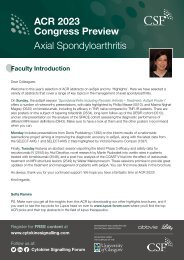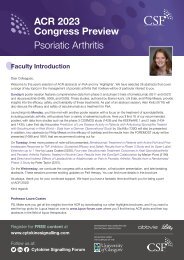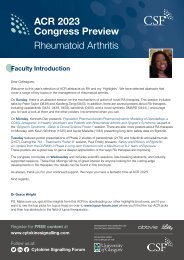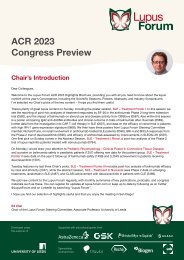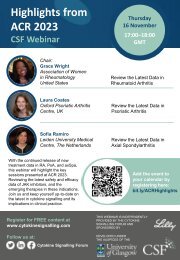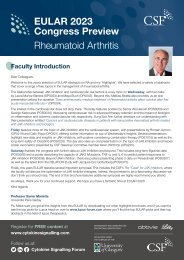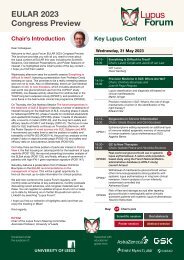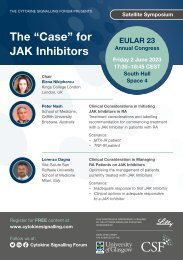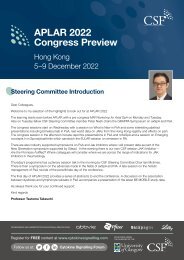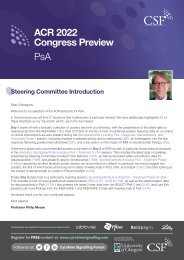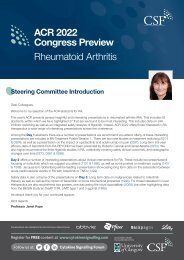Create successful ePaper yourself
Turn your PDF publications into a flip-book with our unique Google optimized e-Paper software.
Phase 2b Studies of ABT-494, a Selective JAK-1 Inhibitor, in<br />
a Patients With Rheumatoid Arthritis
1. Efficacy and Safety of ABT-494, a Selective JAK-1 Inhibitor, in a Phase<br />
IIb Study in Patients With Rheumatoid Arthritis and an Inadequate<br />
Response to Methotrexate<br />
Mark C. <strong>Genovese</strong>, Josef S. Smolen, Michael E. Weinblatt, Gerd R. Burmester, Sebastian<br />
Meerwein, Heidi S. Camp, Li Wang, Ahmed A. Othman, Nasser Khan, Aileen L. Pangan and<br />
Steven Jungerwirth<br />
Arthritis Rheumatol 2016;68:2857–66<br />
2. A Phase IIb Study of ABT-494, a Selective JAK-1 Inhibitor, in<br />
Patients With Rheumatoid Arthritis and an Inadequate Response to<br />
Anti–Tumor Necrosis Factor Therapy<br />
Joel M. <strong>Kremer</strong>, Paul Emery, Heidi S. Camp, Alan Friedman, Li Wang, Ahmed A. Othman,<br />
Nasser Khan, Aileen L. Pangan, Steven Jungerwirth and Edward C. Keystone<br />
Arthritis Rheumatol 2016;68:2867–77
Background and Objectives<br />
• ABT-494 is a novel selective JAK-1 inhibitor<br />
– It is under development for the treatment of moderate to severe RA<br />
• Two Phase 2b studies aimed to compare the efficacy and safety of<br />
various doses of ABT-494 against placebo in RA patients receiving a<br />
stable dose of MTX<br />
– One study included patients with an inadequate response to MTX 1<br />
– The other included patients with an inadequate response to or<br />
intolerance of 1 anti-TNF agent 2<br />
1. <strong>Genovese</strong> MC, et al. Arthritis Rheum 2016;68:2857–66.<br />
2. <strong>Kremer</strong> JM, et al. Arthritis Rheum 2016;68:2867–77.
Methods – Eligibility Criteria<br />
• Inclusion criteria:<br />
– Age ≥18 years<br />
– Active RA (≥6/66 swollen joints and ≥6/68 tender joints)<br />
– hsCRP above upper limit of normal (5 mg/L) or seropositive for both<br />
anti-CCP and rheumatoid factor<br />
– Study 1: Active RA despite MTX treatment 1<br />
‣ Patients were required to discontinue all other DMARDs for a<br />
pre-specified duration before baseline 1<br />
– Study 2: Active RA despite ≥1 anti-TNF treatment for ≥3 months 2<br />
‣ Patients had discontinued TNF therapy because of intolerance or toxicity<br />
‣ All biologic agents had to be washed out prior to randomisation<br />
hsCRP, high-sensitivity C-reactive peptide.<br />
1. <strong>Genovese</strong> MC, et al. Arthritis Rheum 2016;68:2857–66. 2. <strong>Kremer</strong> JM, et al. Arthritis Rheum 2016;68:2867–77.
Methods – Study Design<br />
• These were Phase 2b, randomised, double-blind, placebo-controlled, parallel-group,<br />
multicentre studies<br />
• Eligible patients were randomised 1:1:1:1:1 to receive either placebo BID or<br />
immediate-release oral doses of ABT-494 at 3 mg, 6 mg, 12 mg or 18 mg BID for 12<br />
weeks<br />
– Study 1 included an additional dose of 24 mg once daily<br />
• Patients continued stable-dose MTX (7.5–25 mg/week) and were to take oral folic<br />
acid (or equivalent) from 4 weeks before baseline and throughout the study<br />
• Concurrent treatment was permitted with stable doses of other, non-DMARD<br />
background RA therapy<br />
• Patients who completed the 12-week randomised controlled study completed a<br />
30-day follow-up visit or had the option to enter an open-label extension study<br />
1. <strong>Genovese</strong> MC, et al. Arthritis Rheum 2016;68:2857–66.<br />
2. <strong>Kremer</strong> JM, et al. Arthritis Rheum 2016;68:2867–77.
Methods – Endpoints<br />
• The primary efficacy endpoint was the proportion of patients who<br />
achieved an ACR20 response at Week 12<br />
• Secondary endpoints included:<br />
– Proportion achieving ACR50 and ACR70<br />
– Proportion achieving DAS28(CRP) 3.2 or
Results – Baseline Demographics and Disease Activity (Study 1)<br />
Patient characteristic<br />
Placebo<br />
n=50<br />
3 mg BID<br />
n=50<br />
6 mg BID<br />
n=50<br />
ABT-494<br />
12 mg BID<br />
n=50<br />
18 mg BID<br />
n=50<br />
24 mg QD<br />
n=49<br />
Age, mean (SD), years 55 (12) 53 (12) 55 (12) 56 (12) 55 (14) 56 (12)<br />
Female, n (%) 38 (76) 40 (80) 34 (68) 41 (82) 42 (84) 42 (86)<br />
RA duration, mean (SD), years 5.9 (5.3) 3.9 (3.8) 7.0 (5.5) 9.3 (8.6) 7.3 (7.9) 8.3 (7.1)<br />
Previous non-MTX DMARDs, n<br />
(%)<br />
7 (14) 6 (12) 12 (24) 11 (22) 5 (10) 12 (24)<br />
HAQ-DI score, mean (SD) 1.4 (0.7) 1.3 (0.7) 1.6 (0.7) 1.5 (0.6) 1.6 (0.6) 1.5 (0.7)<br />
DAS28(CRP), mean (SD) 5.6 (1.1) 5.5 (1.1) 5.8 (1.0) 5.6 (0.9) 5.7 (0.8) 5.7 (1.0)<br />
CDAI score, mean (SD) 40 (14) 38 (13) 43 (14) 39 (12) 40 (13) 41 (13)<br />
hsCRP >ULN*, n (%) 27 (54) 25 (50) 31 (62) 26 (52) 28 (56) 33 (67)<br />
hsCRP, high-sensitivity C-reactive peptide; ULN, upper limit of normal (ULN=5 mg/L).<br />
<strong>Genovese</strong> MC, et al. Arthritis Rheum 2016;68:2857–66.
Results – Baseline Demographics and Disease Activity (Study 2)<br />
Patient characteristic<br />
Placebo<br />
n=56<br />
3 mg BID<br />
n=55<br />
6 mg BID<br />
n=55<br />
ABT-494<br />
12 mg BID<br />
n=55<br />
18 mg BID<br />
n=55<br />
Age, mean (SD), years 58 (12) 57 (13) 56 (12) 59 (11) 57 (12)<br />
Female, n (%) 48 (86) 43 (78) 43 (78) 45 (82) 42 (76)<br />
RA duration, mean (SD),<br />
years<br />
Only 1 prior anti-TNF, n<br />
(%)<br />
Prior non-anti-TNF agent,<br />
n (%)<br />
12.1 (9.0) 11.8 (9.4) 12.3 (10.6) 12.2 (10.2) 10.9 (7.7)<br />
42 (76) 39 (71) 38 (70) 38 (72) 38 (69)<br />
9 (16) 10 (18) 14 (26) 14 (26) 7 (13)<br />
HAQ-DI score, mean (SD) 1.6 (0.7) 1.5 (0.7) 1.6 (0.7) 1.6 (0.6) 1.5 (0.6)<br />
DAS28(CRP), mean (SD) 5.8 (0.9) 5.7 (0.9) 5.9 (0.9) 5.7 (0.9) 5.8 (1.0)<br />
CDAI score, mean (SD) 41 (12) 40 (13) 42 (12) 40 (12) 41 (14)<br />
hsCRP >ULN*, n (%) 28 (50) 35 (64) 34 (62) 33 (60) 35 (64)<br />
hsCRP, high-sensitivity C-reactive peptide; ULN, upper limit of normal (ULN=5 mg/L).<br />
<strong>Kremer</strong> JM, et al. Arthritis Rheum 2016;68:2867–77.
Results – Primary Endpoint<br />
MTX inadequate responders<br />
Placebo<br />
ABT-494<br />
3 mg<br />
ABT-494<br />
6 mg<br />
ABT-494<br />
12 mg<br />
ABT-494<br />
18 mg<br />
ABT-494<br />
24 mg<br />
ACR20 rate (%) 46 62 68* 80* 64 76*<br />
*P
Response rate (%)<br />
Response rate (%)<br />
Results – ACR20, ACR50 and ACR70 response rates at Week 12<br />
90<br />
80<br />
70<br />
60<br />
50<br />
40<br />
30<br />
20<br />
*<br />
***<br />
**<br />
Study 1 (MTX-IR) 1 Study 2 (TNF-IR) 2 Placebo<br />
*<br />
***<br />
**<br />
* *<br />
**<br />
**<br />
* *<br />
90<br />
80<br />
70<br />
60<br />
50<br />
40<br />
30<br />
20<br />
*<br />
**<br />
***<br />
***<br />
*<br />
**<br />
**<br />
**<br />
** **<br />
ABT-494 3 mg BID<br />
ABT-494 6 mg BID<br />
ABT-494 12 mg BID<br />
ABT-494 18 mg BID<br />
ABT-494 24 mg QD<br />
10<br />
10<br />
0<br />
ACR20 ACR50 ACR70<br />
0<br />
ACR20 ACR50 ACR70<br />
*P
Response rate (%)<br />
Response rate (%)<br />
Results – DAS28(CRP) Change From Baseline at Week 12<br />
60<br />
60<br />
Study 1 (MTX-IR) 1 Study 2 (TNF-IR) 2 DAS28(CRP)3.2<br />
50<br />
**<br />
***<br />
**<br />
**<br />
50<br />
**<br />
DAS(CRP)
Response rate (%)<br />
Response rate (%)<br />
Results – CDAI Change From Baseline at Week 12<br />
50<br />
45<br />
40<br />
35<br />
30<br />
25<br />
20<br />
15<br />
10<br />
5<br />
0<br />
Placebo<br />
*<br />
ABT-494<br />
3 mg BID<br />
*<br />
ABT-494<br />
6 mg BID<br />
*<br />
ABT-494<br />
12 mg<br />
BID<br />
**<br />
ABT-494<br />
18 mg<br />
BID<br />
ABT-494<br />
24 mg QD<br />
50<br />
45<br />
40<br />
35<br />
30<br />
25<br />
20<br />
15<br />
10<br />
5<br />
0<br />
Placebo ABT-494 3<br />
mg BID<br />
Study 1 (MTX-IR) 1 Study 2 (TNF-IR) 2 CDAI10<br />
ABT-494 6<br />
mg BID<br />
ABT-494<br />
12 mg BID<br />
ABT-494<br />
18 mg BID<br />
CDAI2.8<br />
*P
Results – Safety Data Through Week 12 (Study 1)<br />
Adverse events, n (%)<br />
Placebo<br />
n=50<br />
3 mg BID<br />
n=50<br />
6 mg BID<br />
n=50<br />
ABT-494<br />
12 mg BID<br />
n=50<br />
18 mg BID<br />
n=50<br />
24 mg QD<br />
n=49<br />
Any AE 13 (26) 20 (40) 23 (46) 29 (58) 25 (50) 17 (35)<br />
Any SAE 0 0 2 (4) 1 (2) 3 (6) 2 (4)<br />
Any AE leading to discontinuation 1 (2) 1 (2) 1 (2) 1 (2) 5 (10) 1 (2)<br />
AEs of special interest:<br />
Infection 7 (14) 10 (20) 7 (14) 12 (24) 11 (22) 9 (18)<br />
Serious infections 0 0 0 1 (2) 0 0<br />
Cardiovascular event 0 0 0 1 (2)† 0 0<br />
Herpes zoster* 0 1 (2) 0 0 0 2 (4)<br />
Hepatic disorder 0 1 (2) 0 0 2 (4) 0<br />
Malignancy 0 0 1 (2)‡ 0 0 0<br />
*Events involved 1 dermatome in each patient;†Lung cancer on posttreatment Day 10 in a 79-year-old man who had smoked for 40 years and had<br />
a family history of lung cancer; the patient died 3 months later; ‡Cerebrovascular accident adjudicated as an ishemic stroke.<br />
<strong>Genovese</strong> MC, et al. Arthritis Rheum 2016;68:2857–66.
Results – Safety Data Through Week 12 (Study 2)<br />
Adverse events, n (%)<br />
Placebo<br />
n=56<br />
3 mg BID<br />
n=55<br />
6 mg BID<br />
n=55<br />
ABT-494<br />
12 mg BID<br />
n=55<br />
18 mg BID<br />
n=55<br />
Any AE 25 (45) 26 (47) 31 (56) 37 (67) 39 (71)<br />
Any SAE 1 (2) 2 (4) 2 (4) 0 1 (2)<br />
Any AE leading to discontinuation 2 (4) 0 6 (11) 2 (4) 2 (4)<br />
AEs of special interest*<br />
Infection 12 (23) 11 (20) 12 (22) 22 (40) 21 (38)<br />
Serious infections 1 (2) 0 0 0 0<br />
Cardiovascular event 0 0 1 (2)† 0 0<br />
Herpes zoster 2 (4) 1 (2) 0 1 (2) 1 (2)<br />
Hepatic disorder 1 (2) 0 0 0 2 (4)<br />
Malignancy 0 0 1 (2)‡ 0 0<br />
*Reported by the investigator; †Adjudicated as a transient ischemic attack by an externally led cardiovascular adjudication committee;<br />
‡Basal cell and squamous carcinoma.<br />
<strong>Kremer</strong> JM, et al. Arthritis Rheum 2016;68:2867–77.
Conclusions<br />
• Selective JAK-1 inhibition with ABT-494 was effective in:<br />
– Patients with active RA and an inadequate response to MTX who were<br />
receiving background MTX<br />
– Refractory patients with an inadequate response to or intolerance of 1 anti-<br />
TNF agent<br />
• ABT-494 demonstrated a safety and tolerability profile consistent with other JAK<br />
inhibitors in RA<br />
– With high dosages (12/18 mg BID), the rate of infections was increased (40% in the 12 mg<br />
BID group 2 )<br />
• Larger Phase 3 trials are underway to confirm the selectivity of ABT-494 against JAK-<br />
1 and to determine whether this translates to an improved benefit–risk profile<br />
across a wide spectrum of patients with RA<br />
1. <strong>Genovese</strong> MC, et al. Arthritis Rheum 2016;68:2857–66.<br />
2. <strong>Kremer</strong> JM, et al. Arthritis Rheum 2016;68:2867–77.



